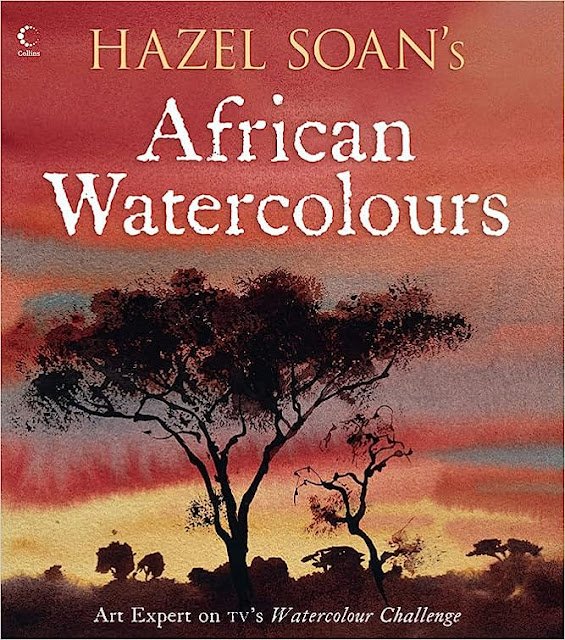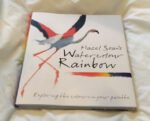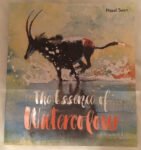Time for another book review. This 128–page paperback has been on my wishlist for a good few years, gradually making its way upwards as other books have made their way onto my shelves. This one arrived at just the right time for me as I have the Schmincke desert supergranulators and and thought this book might generate some good ideas for paintings. I wasn’t expecting to learn much from this one, being under the impression that it was a travelogue, with lots of information about Africa illustrated with paintings but without much painting advice.
The book is probably the most structured book I’ve ever seen. It’s centred around a circular journey through South Africa, Namibia, Botswana and Zimbabwe. A lot of it’s desert there are also seascapes, rivers, lakes, open plains and salt flats. The journey is divided into ten sections, each of which gets its own identically structured twelve page chapter. With one exception, which I’ll get to.
So the way those ten twelve page chapters are structured is:
– On pages 1 and 2 we get a big painting, a geographical title for the chapter, a short poem (presumably written by Hazel) and an art–related subtitle. Those art subtitles relate to things like brush marks, texture, composition,…. that kind of thing.
– On pages 3 and 4 Hazel waxes lyrical about what there is to see on that part of the journey and what great painting subset matter there is to see. And there are some paintings scattered about with a bit of commentary.
– On pages 5 and 6 we start to get some art tips. Not really related to the chapter subtitle but tips nonetheless. And we again get scattered paintings with commentary.
– Page 7 starts with a big heading, and it’s the art–related subheading that we saw on page 2. Pages 7–10 then provide lots of painting advice focused around the area referred to in the subheading. Obviously all illustrated with scattered paintings and commentary.
– Pages 11–12 then close off the chapter. We have a page and a half of “Safari Sketchbook” with some much simpler paintings to look at and then the final half page is a “Campfire Tale” which normally involves scary meetings with wild animals on Hazel’s travels.
The tenth chapter of the book is only ten pages long, with its version of pages 3–4 and 5–6 condensed into just two pages. This breaking of the pattern upset me. If you ever decide to rewrite this book, Hazel, please extend that chapter by two pages and drop a couple of pages from the introduction. It’s what this book deserves.
I always say that I enjoy art books more when the author “has a voice” when I can feel their passion coming through, and when I wouldn’t mind being stuck next them in Starbucks while it was raining outside. Needless to say, this is never a problem with Hazel. The travel talk, the poems, the safari sketchbooks, the campfire tales,…it’s a pleasure to read this book with Hazel for company.
I said at the start that I was expecting this book to be mainly about the travelling with a little bit of painting advice thrown in but it turned out to be the other way round. Most of the advice, though, wasn’t of great use to me at this stage of my career. It’s the level of advice you might expect to see in the first book you read after learning to paint. The market’s saturated with books providing advice at that level but this book stands out as unique, being themed around the story of a journey through Africa. And I also like how it lacks demonstrations or advice on materials compared to those other books.
And, although the book had a different focus to what I was wrongly expecting, this made no difference to the value I got from it. I was always expecting that the value for me was going to be in the form of inspiration, whether that was from talking about places in Africa that I could Google photos of or from just looking at Hazel’s paintings. And that’s what I got out of the book. I’ll probably spot different things every time I look through it but right now I’m looking closely at:
– the white space Hazel leaves on paintings. How much of it there is, where it is, how big it is and what shape it is.
– some of the paintings of wildlife that Hazel seems to create using just yellow ochre and either indigo or Prussian blue. If I were to mimic this I’d be using raw sienna and Mayan blue genuine, as I’m sure y’all know.
So, onto the rating. This definitely isn’t a one palette book. And a book that’s all about inspiration and not about lessons is always going to struggle to get more than three palettes however good it is. According to my
book rating policy, the big question is over whether I’d buy this book again. I’m not sure I would but I do love this book and it seems unfair to only award it two palettes. Instead, I’m going to imagine I’m quite an inexperienced artist, in which case the painting advice in this book becomes more significant and I start to notice how this book compares favourably to other first–books–after–learning–to–paint. I’m awarding three well deserved palettes (and four stars on Amazon).
🎨🎨🎨









Leave a Reply